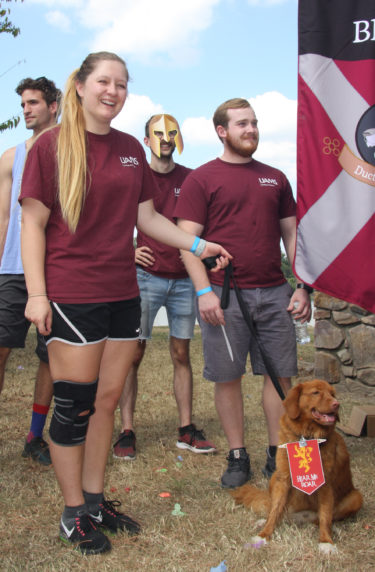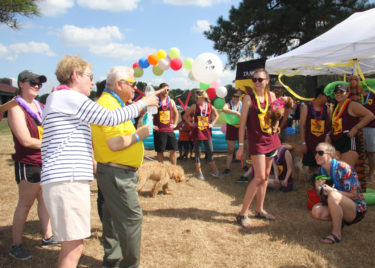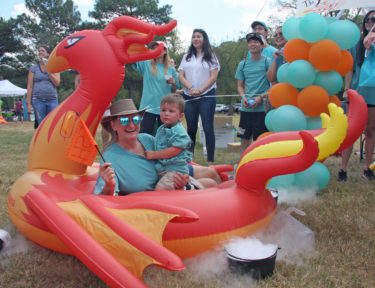College of Medicine Students Get into Spirit at Academic House Olympics
| Medical school isn’t always about books and biology. Sometimes it’s about Baggo and bragging rights.
Such is the case at the Academic House Olympics, an annual event where students, faculty and their families put aside the hard work of medical school for an afternoon to have a little fun. This year’s festivities were held in Murray Park beneath a bright summerlike September sky near the banks of the Arkansas River.
The Academic Houses squared off for a house spirit competition and then broke down into smaller groups to preserve house honor at volleyball, tug of war, Baggo — even Hula-Hooping. The afternoon was interspersed with food, fun, and fellowship, and participants were encouraged to bring family members and pets so that everyone could get a better sense of each other’s lives outside of med school.
“This is all about fun,” said Haley Birch, a fourth-year student in Compton House, which won the spirit competition and was the overall top-scoring team for the Academic House Olympics. “We get to interact with our faculty mentors in a casual atmosphere, see their kids running around, and it all just makes school feel a little bit less academic and more of a social network that we can depend on.”
That feeling is by design. As freshmen, College of Medicine students are divided into one of seven Academic Houses for the duration of medical school. Each house includes students who are at various stages of their training, and each house is shepherded by faculty advisers. The small-group atmosphere facilitates mentorship from the advisers and also between the students. The Academic House system began in 2016 and the Olympics followed in 2017 to deepen those connections.

Students were encouraged to bring family and pets to get to know each other’s lives outside of the classroom.Amy Widner
“We wanted to have an event that would welcome the freshmen medical students, a gathering that would involve family and friends, dogs, babies and really get everybody involved,” said Sara Tariq, M.D., associate dean for student affairs in the College of Medicine. “We also wanted to harness the spirit of competition from the medical students, something fun that would build a sense of comradery.”
Second-year student Olivia Speed of Ish House and her teammates spent about a week working on their phoenix-themed design. They tied for second place in the spirit competition with Tank House and Beall House.
“It’s been phenomenal,” Speed said. “It’s nice to get out of the library and actually spend a weekend having fun, relaxing and hanging out together in a non-school setting. I’ve gotten to know my advisers and the other students better — you find out pretty quick who’s competitive and who’s into trash talk!”

House Tank prepares for judging by Jeannette M. Shorey II, M.D., and Puru Thapa, M.D., Ph.D., (yellow shirt).Amy Widner
However, it’s not all fun and games. Many house activities focus on academic success and preparation for crucial milestone events such as national exams and the increasingly competitive National Resident Matching Program, which determines where physicians will train after graduation. The advisers and upperclassmen help younger students gear up for these challenges.
“We know that sustained professional and personal relationships between students and faculty and among peers contribute to effective learning,” Tariq said. “This is one reason about 60 medical schools across the country — about 40 percent of U.S. medical schools — have adopted academic houses or similar learning communities.”
UAMS’ seven academic houses were named by students in honor of successful UAMS alumni, iconic faculty members, prominent Arkansas physicians and other leaders (all deceased) who made their mark on Arkansas and medicine. For example, Neil Ernest Compton, M.D., graduated from UAMS in 1939, served the U.S. Naval Reserve as a medical officer, and practiced obstetrics and gynecology in northwest Arkansas for decades. Compton was a nationally lauded conservationist and was instrumental in having the Buffalo River of Arkansas designated as the first protected “national river” in the National Park System. Ish House is named for George William Stanley Ish, M.D., a Harvard-trained African American physician who cared for citizens in Little Rock from the 1920s through the 1960s and founded a sanatorium for treating tuberculosis patients.


